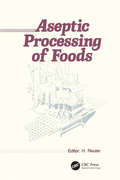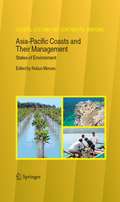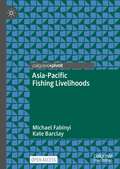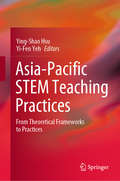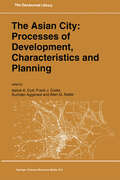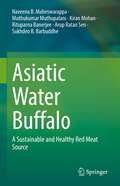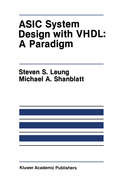- Table View
- List View
Aseptic Processing of Foods
by Helmut ReuterAseptic food processing has become important as a safe and effective method for the preparing and packaging of a variety of foods. This recent book, prepared by a team of European specialists, provides a detailed guide and reference to aseptic food processing technology. All aspects are presented systematically: principles, practice, equipment, applications, packages and packaging, quality control, and safety. All applicable food and beverage categories are examined. More than 130 photographs, diagrams, and other schematics illustrate equipment and their function and a variety of procedures. Tables and graphs provide important quantitative data in convenient form.
Ash from Coal and Biomass Combustion
by Ashok K. Singh Reginald Ebhin Masto Bodhisatwa Hazra Joan Esterle Pradeep K. SinghThis is a concise book with comprehensive information on coal and biomass ash generated from their combustion in thermal power plants. It presents detailed studies on ash generated from contrasting coal and biomass feedstocks, and provides a comparative evaluation of these different ashes in terms of their origin, properties, environmental hazards. Potential utilizations with specific advantages and disadvantages of the respective ashes are elaborated in detail, including some innovative means of ash utilization for value addition purposes. By addressing both the theory and commercial exploitation of these products, this book will be helpful for industrialists, academicians and researchers alike.
The Ashgate Research Companion to Military Ethics (Justice, International Law and Global Security)
by James Turner Johnson Eric D. PattersonThis Companion provides scholars and graduates, serving and retired military professionals, members of the diplomatic and policy communities concerned with security affairs and legal professionals who deal with military law and with international law on armed conflicts, with a comprehensive and authoritative state-of-the-art review of current research in the area of military ethics. Topics in this volume reflect both perennial and pressing contemporary issues in the ethics of the use of military force and are written by established professionals and respected commentators. Subjects are organized by three major perspectives on the use of military force: the decision whether to use military force in a given context, the matter of right conduct in the use of such force, and ethical responsibilities beyond the end of an armed conflict. Treatment of issues in each of these sections takes account of both present-day moral challenges and new approaches to these and the historical tradition of just war. Military ethics, as it has developed, has been a particularly Western concern and this volume reflects that reality. However, in a globalized world, awareness of similarities and differences between Western approaches and those of other major cultures is essential. For this reason the volume concludes with chapters on ethics and war in the Islamic, Chinese, and Indian traditions, with the aim of integrating reflection on these approaches into the broad consideration of military ethics provided by this volume.
The Ashgate Research Companion to Military Ethics (Justice, International Law and Global Security)
by James Turner Johnson Eric D. PattersonThis Companion provides scholars and graduates, serving and retired military professionals, members of the diplomatic and policy communities concerned with security affairs and legal professionals who deal with military law and with international law on armed conflicts, with a comprehensive and authoritative state-of-the-art review of current research in the area of military ethics. Topics in this volume reflect both perennial and pressing contemporary issues in the ethics of the use of military force and are written by established professionals and respected commentators. Subjects are organized by three major perspectives on the use of military force: the decision whether to use military force in a given context, the matter of right conduct in the use of such force, and ethical responsibilities beyond the end of an armed conflict. Treatment of issues in each of these sections takes account of both present-day moral challenges and new approaches to these and the historical tradition of just war. Military ethics, as it has developed, has been a particularly Western concern and this volume reflects that reality. However, in a globalized world, awareness of similarities and differences between Western approaches and those of other major cultures is essential. For this reason the volume concludes with chapters on ethics and war in the Islamic, Chinese, and Indian traditions, with the aim of integrating reflection on these approaches into the broad consideration of military ethics provided by this volume.
The Ashgate Research Companion to War: Origins and Prevention
by Hall Gardner Oleg KobtzeffMany different social scientists have been challenged by the origins of wars, their immediate causes and the mechanisms leading to the breakdown of peaceful relations. Many have speculated whether conflicts were avoidable and whether alternative policies might have prevented conflict. The Ashgate Research Companion to War provides contributions from a number of theorists and historians with a focus on long term, systemic conflicts. The problèmatique is introduced by the Editors highlighting the need for interdisciplinary approaches to the study of war as a global phenomenon. The following 29 essays provide a comprehensive study guide in four sections: Part I explicates differing theories as to the origins of war under the general concept of 'polemology'. Part II analyzes significant conflicts from the Peloponnesian wars to World War II. Part III examines the ramifications of Cold War and post-Cold War conflict. Part IV looks at long cycles of systemic conflict, and speculates, in part, whether another global war is theoretically possible, and if so, whether it can be averted. This comprehensive volume brings us a much needed analysis of wars throughout the ages, their origins, their consequences, and their relationship to the present. A valuable understanding that is ideal for social scientists from a variety of backgrounds.
The Ashgate Research Companion to War: Origins and Prevention
by Hall Gardner Oleg KobtzeffMany different social scientists have been challenged by the origins of wars, their immediate causes and the mechanisms leading to the breakdown of peaceful relations. Many have speculated whether conflicts were avoidable and whether alternative policies might have prevented conflict. The Ashgate Research Companion to War provides contributions from a number of theorists and historians with a focus on long term, systemic conflicts. The problèmatique is introduced by the Editors highlighting the need for interdisciplinary approaches to the study of war as a global phenomenon. The following 29 essays provide a comprehensive study guide in four sections: Part I explicates differing theories as to the origins of war under the general concept of 'polemology'. Part II analyzes significant conflicts from the Peloponnesian wars to World War II. Part III examines the ramifications of Cold War and post-Cold War conflict. Part IV looks at long cycles of systemic conflict, and speculates, in part, whether another global war is theoretically possible, and if so, whether it can be averted. This comprehensive volume brings us a much needed analysis of wars throughout the ages, their origins, their consequences, and their relationship to the present. A valuable understanding that is ideal for social scientists from a variety of backgrounds.
Asia-Pacific Coasts and Their Management: States of Environment (Coastal Systems and Continental Margins #11)
by Nobuo MimuraThe Asia and Pacific region is home to the world’s largest concentration of coral reefs and mangroves. It accommodates two-thirds of the world’s human population and its economic activities have the highest growth rate in the world. This book gives an overview of the state-of-the-art understanding on the drivers, state, and responses to the coastal environmental changes in the Asia and Pacific region. It provides important perspectives on the subject for researchers.
Asia-Pacific Fishing Livelihoods
by Michael Fabinyi Kate BarclayThis open access book explores fishing livelihoods in the context of the wider contexts in which they are embedded. Drawing on case studies from across the Asia-Pacific region, the book highlights how fishing livelihoods are shaped by globalisation, social relationships and governance. The book concludes by showing how better understanding these relationships can contribute to governance for healthier ecosystems and social wellbeing.This is an open access book.This is an open access book.
Asia-Pacific STEM Teaching Practices: From Theoretical Frameworks to Practices
by Ying-Shao Hsu Yi-Fen YehThis book offers various perspectives on the complex and crosscutting concepts of the science, technology, engineering, and mathematics (STEM) disciplines in the classroom context. Presenting empirical studies, it reveals how researchers in the Asia-Pacific Region planned and implemented STEM education in the classroom. Further, it discusses the assessment of STEM learning to clarify what important elements should be included and how researchers and educators frame and design assessment tools. The book consists of four parts: potential and trends in STEM education; teachers’ practical knowledge for STEM teaching; STEM teaching practices; and assessment of STEM learning. Providing evidence on developing curriculums, implementing instructional practices and educating classroom teachers, it is intended for readers wanting to explore STEM education from multiple perspectives.
Asian Berries: Health Benefits (Functional Foods and Nutraceuticals)
by Gengsheng Xiao Yujuan Xu Yuanshan YuAs consumers look to natural foods to promote health and well-being, their focus has been on foods with recognized health properties. Natural health products with rich antioxidant and high free radical scavenging activity such as Asian berries currently draw the interest of scientific researchers, whose goal is to evaluate Asian berries’ nutritional and health-promoting properties. Collected in one source, Asian Berries: Health Benefits covers a wide array of different Asian berries, their properties, potential health benefits, and possible uses. Asian berries are well-known traditional nutritional foods and herbal medicinals as well as valuable nourishing tonic, which has been used for thousands of years in Asian countries. They are traditionally employed as herbal medicinals from ancient times. Recently, Asian berries widely marketed as health foods have become increasingly popular in the Western world because of their health-promoting properties. This book explores a wide array of possibilities and benefits that come from Asian berries. Key Features: Defines chemical, biochemical properties, bioactive components and health benefits of Asian berries Details postharvest storage technology and processing technology development Explains utilization of Asian berries by-products Discusses Asian berries functional foods as well as food safety issues Complete with 18 chapters written by experts in their field, Asian Berries: Health Benefits serves as an excellent reference for anyone interested in the science and technology of bioactive components from Asian berries as health-promoting foods.
Asian Berries: Health Benefits (Functional Foods and Nutraceuticals)
by Gengsheng Xiao Yujuan Xu Yuanshan YuAs consumers look to natural foods to promote health and well-being, their focus has been on foods with recognized health properties. Natural health products with rich antioxidant and high free radical scavenging activity such as Asian berries currently draw the interest of scientific researchers, whose goal is to evaluate Asian berries’ nutritional and health-promoting properties. Collected in one source, Asian Berries: Health Benefits covers a wide array of different Asian berries, their properties, potential health benefits, and possible uses. Asian berries are well-known traditional nutritional foods and herbal medicinals as well as valuable nourishing tonic, which has been used for thousands of years in Asian countries. They are traditionally employed as herbal medicinals from ancient times. Recently, Asian berries widely marketed as health foods have become increasingly popular in the Western world because of their health-promoting properties. This book explores a wide array of possibilities and benefits that come from Asian berries. Key Features: Defines chemical, biochemical properties, bioactive components and health benefits of Asian berries Details postharvest storage technology and processing technology development Explains utilization of Asian berries by-products Discusses Asian berries functional foods as well as food safety issues Complete with 18 chapters written by experts in their field, Asian Berries: Health Benefits serves as an excellent reference for anyone interested in the science and technology of bioactive components from Asian berries as health-promoting foods.
The Asian City: Processes of Development, Characteristics and Planning (GeoJournal Library #30)
by Ashok K. DuttIn The Asian City the Asian urbanisation processes, nature and characteristics of the 1990s have been analyzed by countries, by comparing different countries and in an international context. The authors are urban specialists from four continents. This volume has been divided into six parts: Part I Urbanisation in an international context; Part II Comparative urban setting; Part III Urbanisation characteristics by country; Part IV Urban planning; Part V The urban poor, and Part VI Perspectives on urbanization. This work allows the reader to understand Asian urban forms, their evolution, the nature of urbanisation, its impact on economic growth in cities, the living and working conditions of the poor, and urban planning and problems.
Asian Noodles: Science, Technology, and Processing
by Gary G. HouIn Asian Noodles: Science, Technology and Processing, international experts review the current knowledge and offer comprehensive cutting-edge coverage on Asian noodles unmatchable in any publication. The authors cover an array of topics including breeding for noodle wheat, noodle flour milling, noodle flour quality control and analysis, noodle processing, sensory and instrumental measurements of noodle quality, the effects of wheat factors on noodle quality, packaging and storage, nutritional fortification of noodle products, noodle flavor seasoning, and noodle plant setup and management.
Asian Noodles: Science, Technology, and Processing
by Gary G. HouIn Asian Noodles: Science, Technology and Processing, international experts review the current knowledge and offer comprehensive cutting-edge coverage on Asian noodles unmatchable in any publication. The authors cover an array of topics including breeding for noodle wheat, noodle flour milling, noodle flour quality control and analysis, noodle processing, sensory and instrumental measurements of noodle quality, the effects of wheat factors on noodle quality, packaging and storage, nutritional fortification of noodle products, noodle flavor seasoning, and noodle plant setup and management.
Asian Space Race: Rhetoric or Reality?
by Ajey LeleThis book explores the character and contours of the Asian Space Powers. At present, Asian states like China, Japan and India are found investing in space technologies with analogous social and scientific and probably with divergent military intents. Other Asian states like Israel, South Korea and Malaysia are also making investments in the space arena. States like Iran and North Korea are faulted for using space launches as a demonstrative tool to achieve strategic objectives. This work examines this entire maze of activities to unearth where these states are making these investments to accomplish their state-specific goal or are they also trying to surpass each other by engaging in competition. Explaining why and how these states are making investments towards achieving their socio-economic and strategic mandate this book infers that the possibility of Asian Space Race exists but is presently fairly diminutive.
Asiatic Water Buffalo: A Sustainable and Healthy Red Meat Source
by Naveena B. Maheswarappa Muthukumar Muthupalani Kiran Mohan Rituparna Banerjee Arup Ratan Sen Sukhdeo B. BarbuddheThis need-based unique book deals exclusively with water buffalo (Bubalus bubalis) meat to provide much needed information to thousands of buffalo meat processors across the world. The information provided in this first-of-its-kind book on buffalo meat quality, nutritional characteristics, safety, and processing can be utilized by buffalo meat producers and meat processors for the advancement of the buffalo meat sector. It also provides valuable information to faculty members, students, researchers, and all other readers interested in this new source of meat. Owing to the limited research and scientific literature available on buffalo meat, the authors’ own research findings and our experiences were included wherever required to give crisp, practical, and complete information. The information proposed in this book should be beneficial to the entire buffalo industry, from the farming and processing of buffaloes to the marketing of products. This serve as a handy guide to meat scientists, faculty members, and students willing to learn more about buffalo meat processing. Up-to-date relevant references were also included for the benefit of researchers and students to enable them to easily access further information. Above all, it provides valuable information to consumers who are interested to know this new and potential source of meat.
ASIC and FPGA Verification: A Guide to Component Modeling (ISSN)
by Richard MundenRichard Munden demonstrates how to create and use simulation models for verifying ASIC and FPGA designs and board-level designs that use off-the-shelf digital components. Based on the VHDL/VITAL standard, these models include timing constraints and propagation delays that are required for accurate verification of today’s digital designs. ASIC and FPGA Verification: A Guide to Component Modeling expertly illustrates how ASICs and FPGAs can be verified in the larger context of a board or a system. It is a valuable resource for any designer who simulates multi-chip digital designs.*Provides numerous models and a clearly defined methodology for performing board-level simulation.*Covers the details of modeling for verification of both logic and timing. *First book to collect and teach techniques for using VHDL to model "off-the-shelf" or "IP" digital components for use in FPGA and board-level design verification.
ASIC Design and Synthesis: RTL Design Using Verilog
by Vaibbhav TaraateThis book describes simple to complex ASIC design practical scenarios using Verilog. It builds a story from the basic fundamentals of ASIC designs to advanced RTL design concepts using Verilog. Looking at current trends of miniaturization, the contents provide practical information on the issues in ASIC design and synthesis using Synopsys DC and their solution. The book explains how to write efficient RTL using Verilog and how to improve design performance. It also covers architecture design strategies, multiple clock domain designs, low-power design techniques, DFT, pre-layout STA and the overall ASIC design flow with case studies. The contents of this book will be useful to practicing hardware engineers, students, and hobbyists looking to learn about ASIC design and synthesis.
ASIC Design Implementation Process: A Complete Framework
by Khosrow GolshanThis book is an easy-to-read guide, providing a complete framework for the ASIC design process. Based on the author’s extensive experience leading ASIC design teams, this book emphasizes short, clear descriptions, supplemented by references to authoritative manuscripts. This approach presents the essence of the ASIC design implementation process for those involved in a specific part of the process, while providing knowledge of the entire process.
An ASIC Low Power Primer: Analysis, Techniques and Specification
by Rakesh Chadha J. BhaskerThis book provides an invaluable primer on the techniques utilized in the design of low power digital semiconductor devices. Readers will benefit from the hands-on approach which starts form the ground-up, explaining with basic examples what power is, how it is measured and how it impacts on the design process of application-specific integrated circuits (ASICs). The authors use both the Unified Power Format (UPF) and Common Power Format (CPF) to describe in detail the power intent for an ASIC and then guide readers through a variety of architectural and implementation techniques that will help meet the power intent. From analyzing system power consumption, to techniques that can be employed in a low power design, to a detailed description of two alternate standards for capturing the power directives at various phases of the design, this book is filled with information that will give ASIC designers a competitive edge in low-power design.
ASIC/SoC Functional Design Verification: A Comprehensive Guide to Technologies and Methodologies
by Ashok B. MehtaThis book describes in detail all required technologies and methodologies needed to create a comprehensive, functional design verification strategy and environment to tackle the toughest job of guaranteeing first-pass working silicon. The author first outlines all of the verification sub-fields at a high level, with just enough depth to allow an engineer to grasp the field before delving into its detail. He then describes in detail industry standard technologies such as UVM (Universal Verification Methodology), SVA (SystemVerilog Assertions), SFC (SystemVerilog Functional Coverage), CDV (Coverage Driven Verification), Low Power Verification (Unified Power Format UPF), AMS (Analog Mixed Signal) verification, Virtual Platform TLM2.0/ESL (Electronic System Level) methodology, Static Formal Verification, Logic Equivalency Check (LEC), Hardware Acceleration, Hardware Emulation, Hardware/Software Co-verification, Power Performance Area (PPA) analysis on a virtual platform, Reuse Methodology from Algorithm/ESL to RTL, and other overall methodologies.
ASIC System Design with VHDL: A Paradigm (The Springer International Series in Engineering and Computer Science #75)
by Steven S. Leung Michael A. ShanblattBeginning in the mid 1980's, VLSI technology had begun to advance in two directions. Pushing the limit of integration, ULSI (Ultra Large Scale Integration) represents the frontier of the semiconductor processing technology in the campaign to conquer the submicron realm. The application of ULSI, however, is at present largely confined in the area of memory designs, and as such, its impact on traditional, microprocessor-based system design is modest. If advancement in this direction is merely a natural extrapolation from the previous integration generations, then the rise of ASIC (Application-Specific Integrated Circuit) is an unequivocal signal that a directional change in the discipline of system design is in effect. In contrast to ULSI, ASIC employs only well proven technology, and hence is usually at least one generation behind the most advanced processing technology. In spite of this apparent disadvantage, ASIC has become the mainstream of VLSI design and the technology base of numerous entrepreneurial opportunities ranging from PC clones to supercomputers. Unlike ULSI whose complexity can be hidden inside a memory chip or a standard component and thus can be accommodated by traditional system design methods, ASIC requires system designers to master a much larger body of knowledge spanning from processing technology and circuit techniques to architecture principles and algorithm characteristics. Integrating knowledge in these various areas has become the precondition for integrating devices and functions into an ASIC chip in a market-oriented environment. But knowledge is of two kinds.
Asiengeschäfte mit Erfolg: Leitfaden und Checklisten für Fern- und Südostasien
by Sung-Hee LeeDie Märkte Asiens sind wegen der überproportional wachsenden Kaufkraft und der ernormen Devisenreserven bei ausländischen Investoren nach wie vor hoch begehrt. Wer auf diesem Markt Erfolg haben will, muss Wissen über kulturelle Besonderheiten und interkulturelle Kompetenz mitbringen: Wie sind die Businessgepflogenheiten, wo lauern die Tücken im Verhandlungsalltag? Was gilt es bei der Produktgestaltung zu berücksichtigen? Das Buch bietet Antworten auf diese und andere Fragen sowie weitere nützliche Informationen zum Asiengeschäft.
